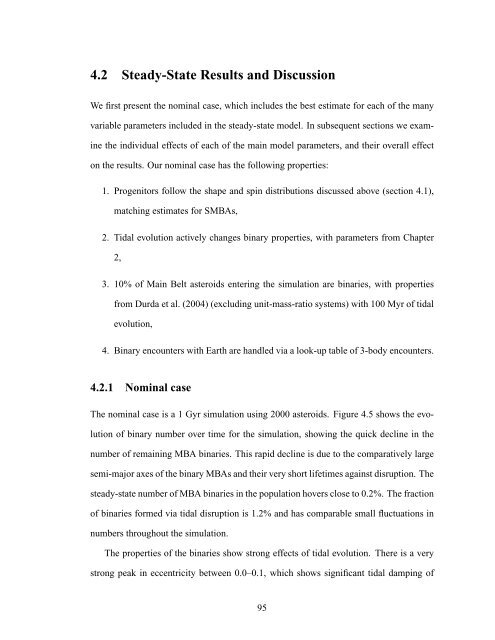Forming Binary Near-Earth Asteroids From Tidal Disruptions
Forming Binary Near-Earth Asteroids From Tidal Disruptions
Forming Binary Near-Earth Asteroids From Tidal Disruptions
Create successful ePaper yourself
Turn your PDF publications into a flip-book with our unique Google optimized e-Paper software.
4.2 Steady-State Results and DiscussionWe first present the nominal case, which includes the best estimate for each of the manyvariable parameters included in the steady-state model. In subsequent sections we examinethe individual effects of each of the main model parameters, and their overall effecton the results. Our nominal case has the following properties:1. Progenitors follow the shape and spin distributions discussed above (section 4.1),matching estimates for SMBAs,2. <strong>Tidal</strong> evolution actively changes binary properties, with parameters from Chapter2,3. 10% of Main Belt asteroids entering the simulation are binaries, with propertiesfrom Durda et al. (2004) (excluding unit-mass-ratio systems) with 100 Myr of tidalevolution,4. <strong>Binary</strong> encounters with <strong>Earth</strong> are handled via a look-up table of 3-body encounters.4.2.1 Nominal caseThe nominal case is a 1 Gyr simulation using 2000 asteroids. Figure 4.5 shows the evolutionof binary number over time for the simulation, showing the quick decline in thenumber of remaining MBA binaries. This rapid decline is due to the comparatively largesemi-major axes of the binary MBAs and their very short lifetimes against disruption. Thesteady-state number of MBA binaries in the population hovers close to 0.2%. The fractionof binaries formed via tidal disruption is 1.2% and has comparable small fluctuations innumbers throughout the simulation.The properties of the binaries show strong effects of tidal evolution. There is a verystrong peak in eccentricity between 0.0–0.1, which shows significant tidal damping of95












